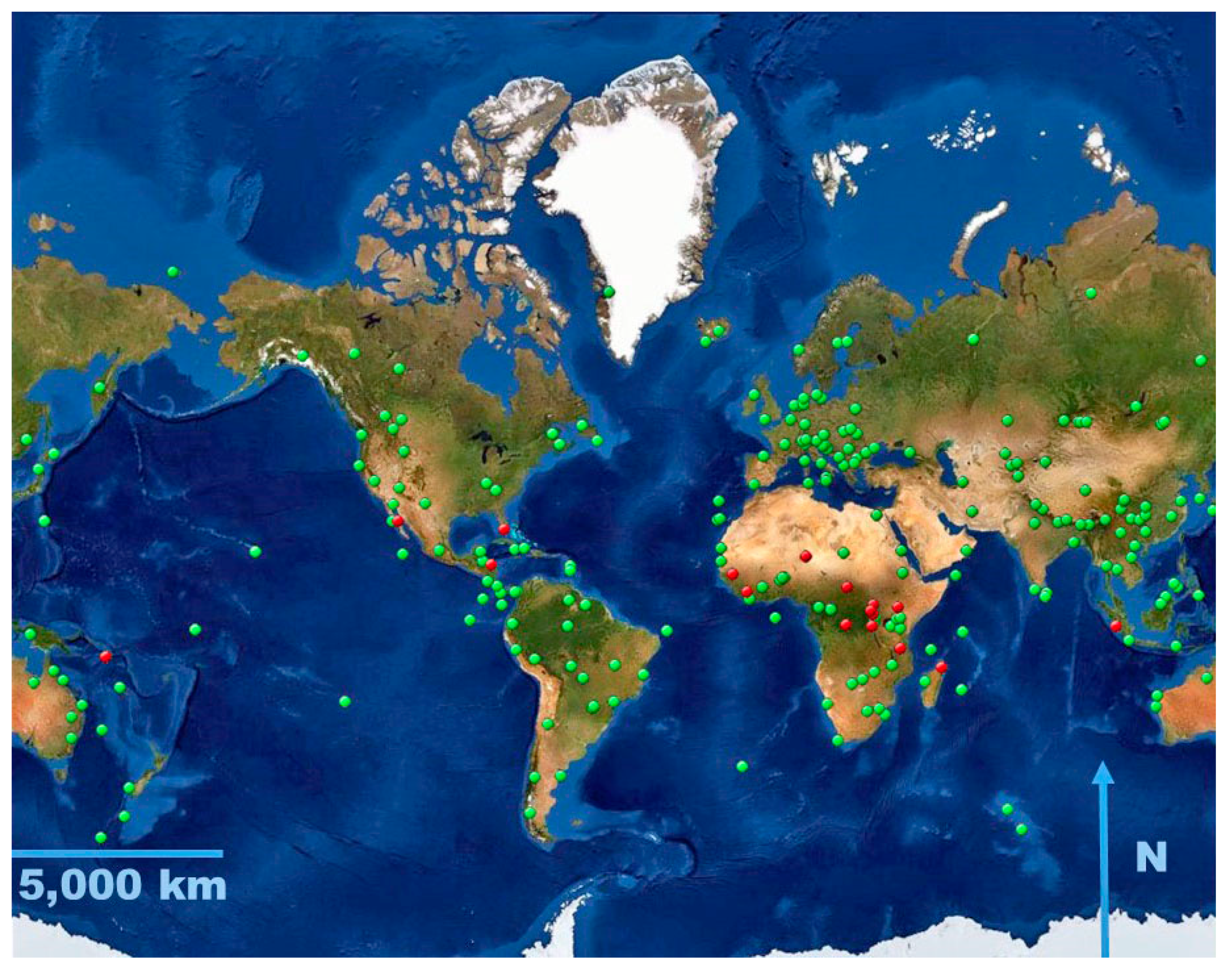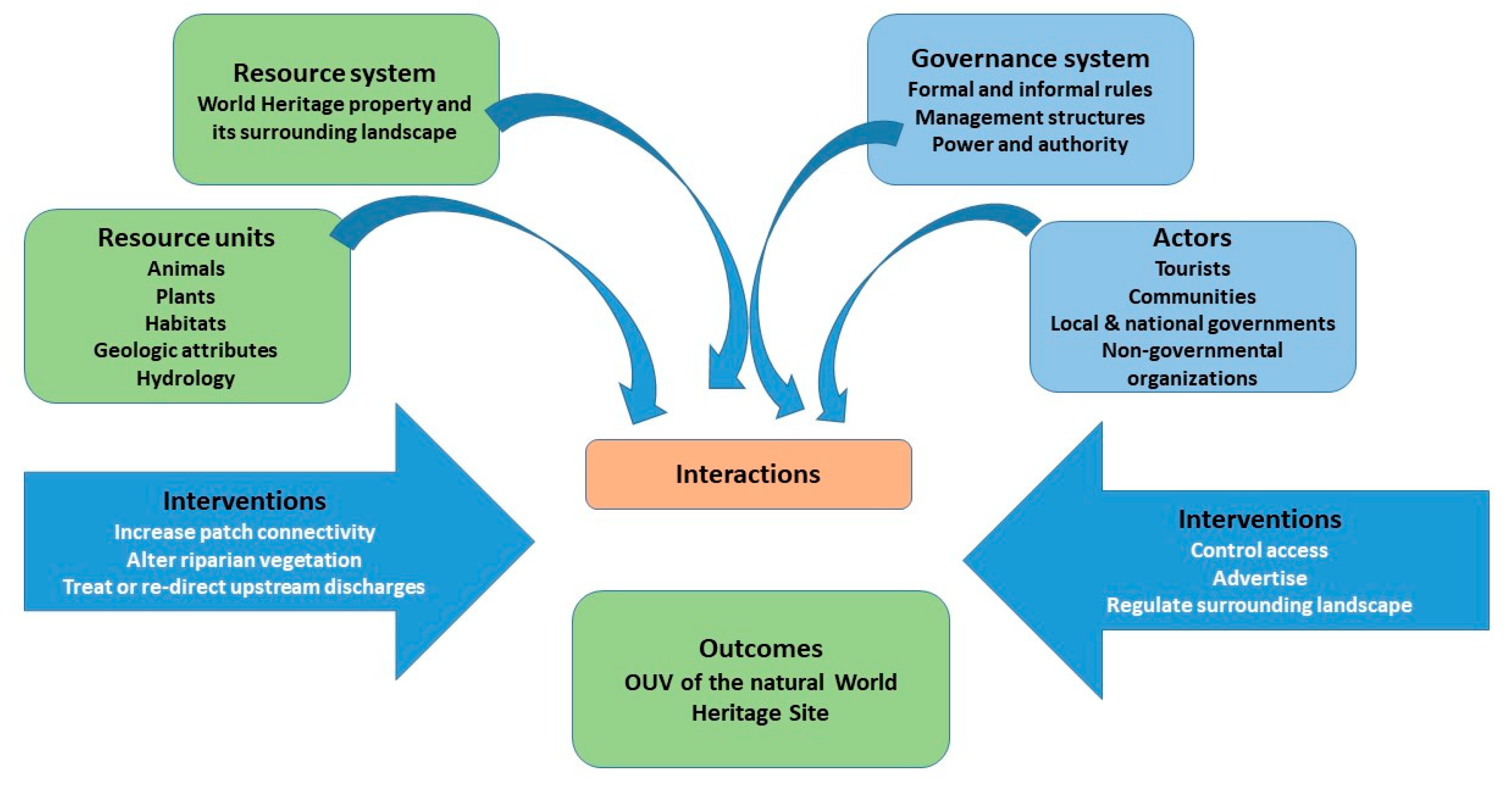Climate Change Adaptation in Natural World Heritage Sites: A Triage Approach
Abstract
1. Introduction
2. Risks that Climate Change Poses to Natural World Heritage Sites
3. Triage as Guidance for Prioritization
4. Guidance for Triage-Based Decisions
5. Sustaining an Evolving Outstanding Universal Value: Manage with Transparency and Accountability
6. Conclusions
Funding
Acknowledgments
Conflicts of Interest
References
- Ficek, R.E. Cattle, Capital, Colonization: Tracking Creatures of the Anthropocene in and out of Human Projects. Curr. Anthr. 2019, 60, S260–S271. [Google Scholar] [CrossRef]
- Flitcroft, R.; Cooperman, M.S.; Harrison, I.J.; Juffe-Bignoli, D.; Boon, P.J. Theory and practice to conserve freshwater biodiversity in the Anthropocene. Aquat. Conserv. Mar. Freshw. Ecosyst. 2019, 29, 1013–1021. [Google Scholar] [CrossRef]
- Harrison, H. Beyond “cultural” and “natural” heritage: Toward an ontological politics of heritage in the Anthropocene. Herit. Soc. 2015, 8, 24–42. [Google Scholar] [CrossRef]
- Pagani-Núñez, E.; Liang, D.; He, C.; Zhou, X.; Luo, X.; Liu, Y.; Goodale, E. Niches in the Anthropocene: Passerine assemblages show niche expansion from natural to urban habitats. Ecography 2019, 42, 1360–1369. [Google Scholar] [CrossRef]
- Sebastián-González, E.; Barbosa, J.M.; Pérez-García, J.M.; Morales-Reyes, Z.; Botella, F.; Olea, P.P.; Mateo-Tomás, P.; Moleón, M.; Hiraldo, F.; Arrondo, E.; et al. Scavenging in the Anthropocene: Human impact drives vertebrate scavenger species richness at a global scale. Glob. Chang. Biol. 2019, 25, 3005–3017. [Google Scholar] [CrossRef] [PubMed]
- IPCC. AR5 Synthesis Report: Climate Change 2014. Available online: https://www.ipcc.ch/report/ar5/syr/ (accessed on 5 August 2019).
- UNFCCC. Bali Climate Change Conference. 2007. Available online: https://unfccc.int/process-and-meetings/conferences/past-conferences/bali-climate-change-conference-december-2007/bali-climate-change-conference-december-2007-0 (accessed on 5 August 2019).
- Mathevet, R.; Thompson, J.D.; Folke, C.; Chapin, F.S. Protected areas and their surrounding territory: Socioecological systems in the context of ecological solidarity. Ecol. Appl. 2016, 26, 5–16. [Google Scholar] [CrossRef] [PubMed]
- Nkoana, E.M.; Waas, T.; Verbruggen, A.; Burman, C.J.; Huge, J. Analytic framework for assessing participation processes and outcomes of climate change adaptation tools. Environ. Dev. Sustain. 2017, 19, 1731–1760. [Google Scholar] [CrossRef]
- Burns, W.C. Belt and Suspenders? The World Heritage Convention’s Role in Confronting Climate Change. Rev. Eur. Community Int. Environ. Law 2009, 18, 148–163. [Google Scholar] [CrossRef]
- Howard, A.J. Managing global heritage in the face of future climate change: The importance of understanding geological and geomorphological processes and hazards. Int. J. Herit. Stud. 2013, 19, 632–658. [Google Scholar] [CrossRef]
- Hilbert, D.W.; Ostendorf, B.; Hopkins, M.S. Sensitivity of tropical forests to climate change in the humid tropics of north Queensland. Austral Ecol. 2001, 26, 590–603. [Google Scholar] [CrossRef]
- Ostendorf, B.; Hilbert, D.W.; Hopkins, M.S. The effect of climate change on tropical rainforest vegetation pattern. Ecol. Model. 2001, 145, 211–224. [Google Scholar] [CrossRef]
- Williams, S.E.; Bolitho, E.E.; Fox, S. Climate change in Australian tropical rainforests: An impending environmental catastrophe. Proc. R. Soc. B Biol. Sci. 2003, 270, 1887–1892. [Google Scholar] [CrossRef] [PubMed]
- ABC News. World Heritage Sites ‘Threatened by Climate Change’. 2008. Available online: https://www.abc.net.au/news/2008-06-21/world-heritage-sites-threatened-by-climate-change/2479250 (accessed on 21 August 2019).
- Phillips, H. Adaptation to Climate Change at UK World Heritage Sites: Progress and Challenges. Hist. Environ. 2014, 5, 288–299. [Google Scholar] [CrossRef]
- UNESCO. Protecting and Managing Effects of Climate Change on World Heritage. Report to the 30th World Heritage Committee Meeting, Vilnius. 2006. Available online: http://whc.unesco.org/document/6670%20 (accessed on 21 August 2019).
- UNESCO. Policy Document on the Impacts of Climate Change on World Heritage on World Heritage Properties. 2008. Available online: https://whc.unesco.org/en/news/441 (accessed on 21 August 2019).
- IUCN. Climate Change and World Heritage. Available online: https://www.iucn.org/theme/world-heritage/our-work/global-world-heritage-projects/climate-change-and-world-heritage (accessed on 20 August 2019).
- ICOMOS. ND. Resolution on Climate Change and Cultural Heritage. Available online: https://www.usicomos.org/icomos-passes-resolution-on-climate-change-and-cultural-heritage/ (accessed on 20 August 2019).
- EarthJustice. World Heritage and Climate Change: The Legal Responsibility of States to Reduce Their Contributions to Climate Change. A Great Barrier Reef Case Study. 2017. Available online: http://earthjustice.org/sites/default/files/files/World-Heritage-Climate-Change_March-2017.pdf (accessed on 20 August 2019).
- NESCO World Heritage Centre. 2017 Operational Guidelines. Available online: https://whc.unesco.org/document/163852 (accessed on 30 August 2019).
- Tanner-McAllister, S.L.; Rhodes, J.; Hockings, M. Managing for climate change on protected areas: An adaptive management decision making framework. J. Environ. Manag. 2017, 204, 510–518. [Google Scholar] [CrossRef] [PubMed]
- Zaccarelli, N.; Riitters, K.; Petrosillo, I.; Zurlini, G. Indicating disturbance content and context for preserved areas. Ecol. Indic. 2008, 8, 841–853. [Google Scholar] [CrossRef]
- Hardisty, A.R.; Michener, W.K.; Agosti, D.; García, E.A.; Bastin, L.; Belbin, L.; Bowser, A.; Buttigieg, P.L.; Canhos, D.A.; Egloff, W.; et al. The Bari Manifesto: An interoperability framework for essential biodiversity variables. Ecol. Inform. 2019, 49, 22–31. [Google Scholar] [CrossRef]
- Wu, J.X.; Wilsey, C.B.; Taylor, L.; Schuurman, G.W. Projected avifaunal responses to climate change across the U.S. National Park System. PLoS ONE 2018, 13, e0190557. [Google Scholar] [CrossRef]
- McNeely, J.A. Protected Areas, Biodiversity, and the Risks of Climate Change. Adv. Nat. Technol. Hazards Res. 2016, 42, 379–397. [Google Scholar]
- Hulme, M.; Dessai, S. Negotiating future climates for public policy: A critical assessment of the development of climate scenarios for the UK. Environ. Sci. Policy 2008, 11, 54–70. [Google Scholar] [CrossRef]
- Rehm, E.M.; Olivas, P.; Stroud, J.; Feeley, K.J. Losing your edge: Climate change and the conservation value of range-edge populations. Ecol. Evol. 2015, 5, 4315–4326. [Google Scholar] [CrossRef]
- Villa, P.M.; Perez-Sanchez, A.J.; Nava, F.; Acevedo, A.; Cadenas, D.A. Local-scale Seasonality Shapes Anuran Community Abundance in a Cloud Forest of the Tropical Andes. Zool. Stud. 2019, 58, 17. [Google Scholar]
- Fadrique, B.; Báez, S.; Duque, Á.; Malizia, A.; Blundo, C.; Carilla, J.; Osinaga-Acosta, O.; Malizia, L.; Silman, M.; Farfán-Ríos, W.; et al. Widespread but heterogeneous responses of Andean forests to climate change. Nature 2018, 564, 207–212. [Google Scholar] [CrossRef] [PubMed]
- Bove, C.B.; Ries, J.B.; Davies, S.W.; Westfield, I.T.; Umbanhowar, J.; Castillo, K.D. Common Caribbean corals exhibit highly variable responses to future acidification and warming. Proc. R. Soc. B: Biol. Sci. 2019, 286, 20182840. [Google Scholar] [CrossRef] [PubMed]
- Pisapia, C.; Burn, D.; Pratchett, M.S. Changes in the population and community structure of corals during recent disturbances (February 2016–October 2017) on Maldivian coral reefs. Sci. Rep. 2019, 9, 842. [Google Scholar] [CrossRef] [PubMed]
- Putra, R.D.; Suhana, M.P.; Kurniawn, D.; Abrar, M.; Siringoringo, R.M.; Sari, N.W.P.; Irawan, H.; Prayetno, E.; Apriadi, T.; Suryanti, A. Detection of reef scale thermal stress with Aqua and Terra MODIS satellite for coral bleaching phenomena. AIP Conf. Proc. 2019, 2094, 020024. [Google Scholar]
- Perry, J. World Heritage hot spots: A global model identifies the 16 natural heritage properties on the World Heritage List most at risk from climate change. Int. J. Herit. Stud. 2011, 17, 426–441. [Google Scholar] [CrossRef]
- Perry, J.; Falzon, C. Climate Change Adaptation for Natural World Heritage Sites: A Practical Guide; World Heritage Papers. 37; UNESCO: Paris, France, 2014; 88p, Available online: http://whc.unesco.org/document/129276 (accessed on 5 August 2019).
- Perry, J. Climate change adaptation in the world’s best places: A wicked problem in need of immediate attention. Landsc. Urban Plan. 2015, 133, 1–11. [Google Scholar] [CrossRef]
- Lawler, J.J. Climate Change Adaptation Strategies for Resource Management and Conservation Planning. Ann. N. Y. Acad. Sci. 2009, 1162, 79–98. [Google Scholar] [CrossRef]
- Reimann, L.; Vafeidis, A.T.; Brown, S.; Hinkel, J.; Tol, R.S.J. Mediterranean UNESCO World Heritage at risk from coastal flooding and erosion due to sea-level rise. Nat. Commun. 2018, 9, 4161. [Google Scholar] [CrossRef]
- Krosby, M.; Theobald, D.M.; Norheim, R.; McRae, B.H. Identifying riparian climate corridors to inform climate adaptation planning. PLoS ONE 2018, 13, e0205156. [Google Scholar] [CrossRef]
- Bottrill, M.C.; Joseph, L.N.; Carwardine, J.; Bode, M.; Cook, C.; Game, E.T.; Grantham, H.; Kark, S.; Linke, S.; McDonald-Madden, E.; et al. Is conservation triage just smart decision making? Trends Ecol. Evol. 2008, 23, 649–654. [Google Scholar] [CrossRef] [PubMed]
- Taboroff, J. Cultural heritage and natural disasters: Incentives for risk management and mitigation. In Managing Disaster Risk in Emerging Economies; World Bank: New York, NY, USA, 2000; Volume 2, pp. 71–79. [Google Scholar]
- Djalante, R.; Thomalla, F. Disaster risk reduction and climate adaptation in Indonesia-institutional challenges and opportunities for integration. Int. J. Disaster Resil. Built Environ. 2012, 3, 169–180. [Google Scholar]
- O’Brien, G.; O’Keefe, P.; Jayawickrama, J.; Jigyasu, R. Developing a model for building resilience to climate risks for cultural heritage. J. Cult. Herit. Manag. Sustain. Dev. 2015, 5, 99–114. [Google Scholar] [CrossRef]
- Wei, J.; Zhao, Y.; Xu, H.; Yu, H. A framework for selecting indicators to assess the sustainable development of the natural heritage site. J. Mt. Sci. 2007, 4, 321–330. [Google Scholar] [CrossRef]
- Rumsey, M.; Fletcher, S.M.; Thiessen, J.; Gero, A.; Kuruppu, N.; Daly, J.; Buchan, J.; Willetts, J. A qualitative examination of the health workforce needs during climate change disaster response in Pacific Island Countries. Hum. Resour. Health 2014, 12, 9. [Google Scholar] [CrossRef] [PubMed]
- Cumming, G.S.; Allen, C.R.; Ban, N.C.; Biggs, D.; Biggs, H.C.; Cumming, D.H.M.; De Vos, A.; Epstein, G.; Etienne, M.; Maciejewski, K.; et al. Understanding protected area resilience: A multi-scale, social-ecological approach. Ecol. Appl. 2015, 25, 299–319. [Google Scholar] [CrossRef] [PubMed]
- Agrawal, A.; Gupta, K. Decentralization and Participation: The Governance of Common Pool Resources in Nepal’s Terai. World Dev. 2005, 33, 1101–1114. [Google Scholar] [CrossRef]
- Clement, S.; Moore, S.A.; Lockwood, M.; Mitchell, M. Using insights from pragmatism to develop reforms that strengthen institutional competence for conserving biodiversity. Policy Sci. 2015, 48, 463–489. [Google Scholar] [CrossRef]
- Beeton, T.A.; McNeeley, S.M.; Miller, B.W.; Ojima, D.S. Grounding simulation models with qualitative case studies: Toward a holistic framework to make climate science usable for US public land management. Clim. Risk Manag. 2019, 23, 50–66. [Google Scholar] [CrossRef]
- Kabat, P.; Bazelmans, J.; Van Dijk, J.; Herman, P.M.; Van Oijen, T.; Pejrup, M.; Reise, K.; Speelman, H.; Wolff, W.J. The Wadden Sea Region: Towards a science for sustainable development. Ocean Coast. Manag. 2012, 68, 4–17. [Google Scholar] [CrossRef]
- Ojoyi, M.; Mutanga, O.; Kahinda, J.M.; Odindi, J.; Abdel-Rahman, E.; Kahinda, J.-M.M. Scenario-based approach in dealing with climate change impacts in Central Tanzania. Futures 2017, 85, 30–41. [Google Scholar] [CrossRef]
- Hassan, K.; Higham, J.; Wooliscroft, B.; Hopkins, D. Climate change and world heritage: A cross-border analysis of the Sundarbans (Bangladesh-India). J. Policy Res. Tour. Leis. Events 2019, 11, 196–219. [Google Scholar] [CrossRef]
- Fischman, R.L.; Meretsky, V.J.; Babko, A.; Kennedy, M.; Liu, L.; Robinson, M.; Wambugu, S. Planning for Adaptation to Climate Change: Lessons from the US National Wildlife Refuge System. BioScience 2014, 64, 993–1005. [Google Scholar] [CrossRef]
- Hansen, A.J.; Davis, C.R.; Piekielek, N.; Gropss, J.; Thebold, D.M.; Goetz, S.; Melton, F.; DeFries, R. Delineating the Ecosystems Containing Protected Areas for Monitoring and Management BioScience 2011, 61, 363–273. BioScience 2011, 61, 363–373. [Google Scholar] [CrossRef]
- Jones, K.R.; Watson, J.E.M.; Possingham, H.P.; Klein, C.J. Incorporating climate change into spatial conservation prioritisation: A review. Biol. Conserv. 2019, 194, 121–130. [Google Scholar] [CrossRef]



© 2019 by the author. Licensee MDPI, Basel, Switzerland. This article is an open access article distributed under the terms and conditions of the Creative Commons Attribution (CC BY) license (http://creativecommons.org/licenses/by/4.0/).
Share and Cite
Perry, J. Climate Change Adaptation in Natural World Heritage Sites: A Triage Approach. Climate 2019, 7, 105. https://doi.org/10.3390/cli7090105
Perry J. Climate Change Adaptation in Natural World Heritage Sites: A Triage Approach. Climate. 2019; 7(9):105. https://doi.org/10.3390/cli7090105
Chicago/Turabian StylePerry, Jim. 2019. "Climate Change Adaptation in Natural World Heritage Sites: A Triage Approach" Climate 7, no. 9: 105. https://doi.org/10.3390/cli7090105
APA StylePerry, J. (2019). Climate Change Adaptation in Natural World Heritage Sites: A Triage Approach. Climate, 7(9), 105. https://doi.org/10.3390/cli7090105



